LO8 (Neural Tissue) Bio 241 Chapter 12 Learning Objectives
1/54
There's no tags or description
Looks like no tags are added yet.
Name | Mastery | Learn | Test | Matching | Spaced |
|---|
No study sessions yet.
55 Terms
What are the two anatomical divisions of the nervous system, and what does each consist of?
PNS – Peripheral Nervous System
Nerves – bundles of axons of neuron
Ganglia – clusters of neuron cell bodies located along nerves
CNS – Central Nervous System
Brain – protected & enclosed within the skull
Spinal Cord – protected & housed within the vertebral canal
Create a flow chart that summarizes the PNS. Include the afferent division, efferent division, somatic nervous system, and autonomic nervous system and use arrows to indicate the direction in which each carries information.
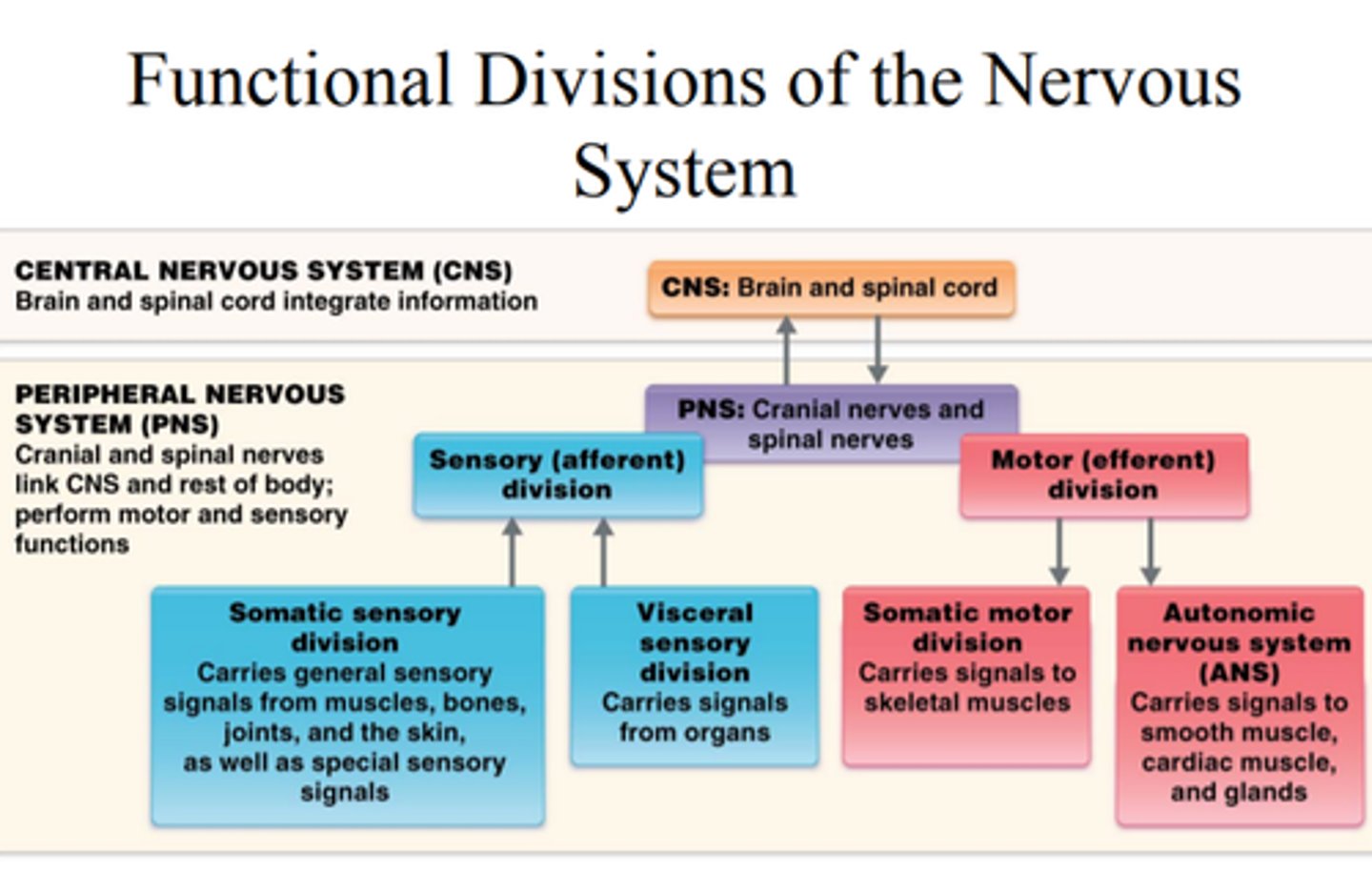
Draw a multipolar neuron and label the following parts: cell body, dendrites, axon, synaptic terminals, axon hillock, myelin sheath (aka myelinated internode), nodes of Ranvier.
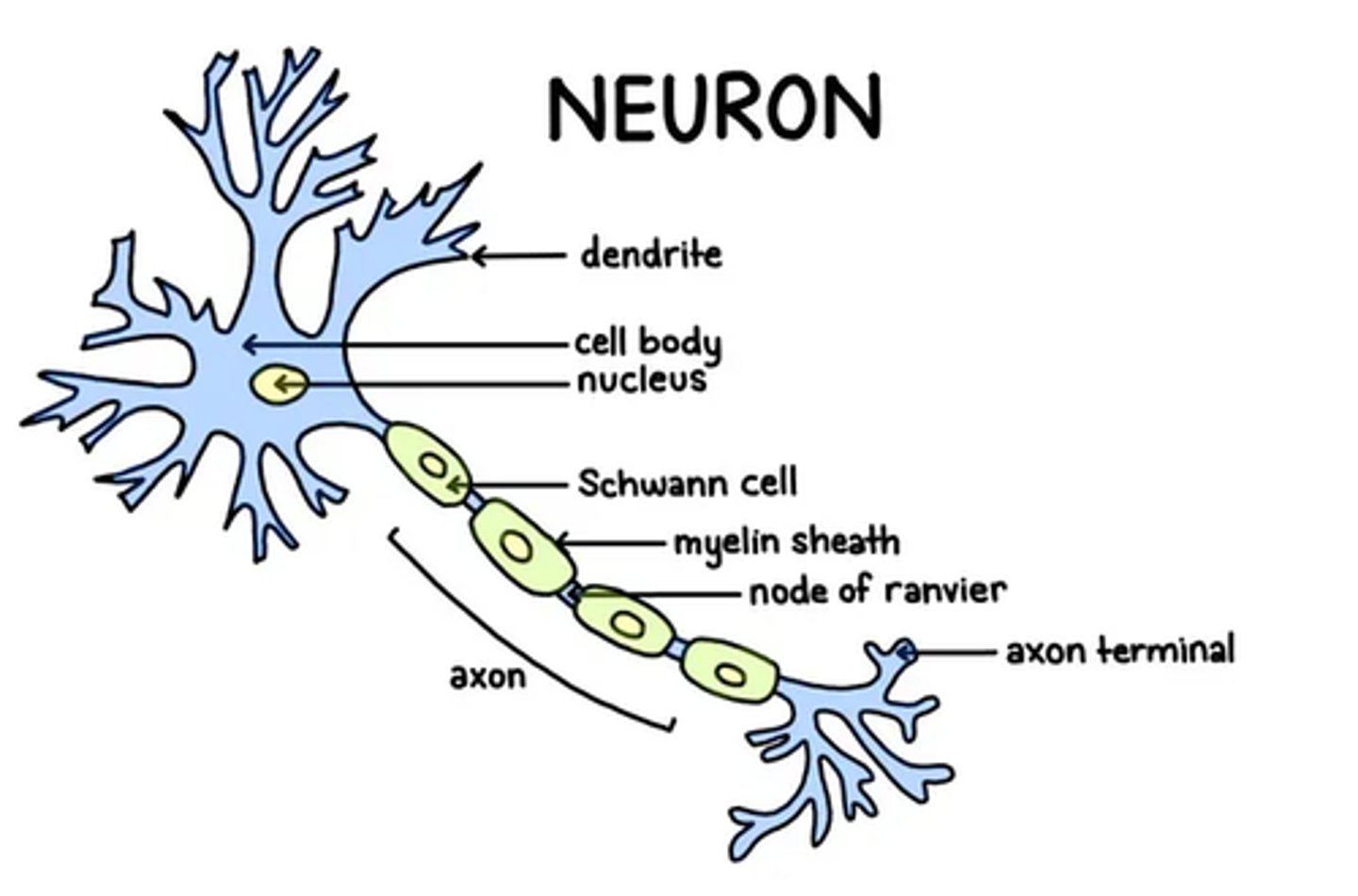
What is the significance of a synapse?
Synapse - functional contact of a neuron with another neuron or effector (muscle or gland)
Significance - essential to the transmission of nervous impulses from one neuron to another
Location - where the neuron is functionally connected either to another neuron or an effector.
Define neuromuscular junction
synapse between a motor neuron and a muscle fiber
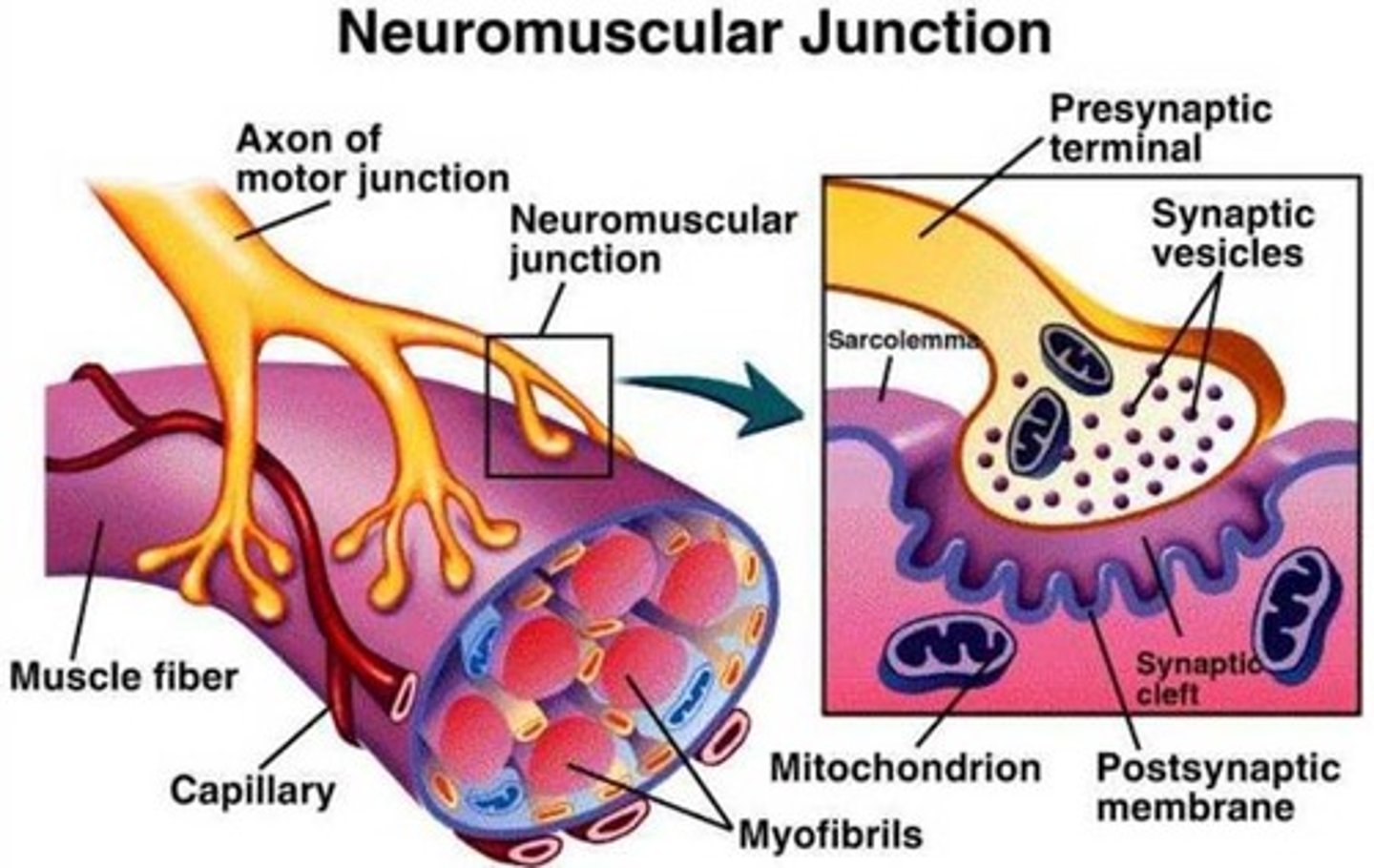
Define neuroglandular junction
synapse between a motor neuron and a gland
Define axoplasmic transport.
(axoplasmic flow) cellular process responsible for movement of enzymes, cytoskeletal components and new axoplasm for regenerating axons, from the cell body toward the synaptic knob (anterograde).
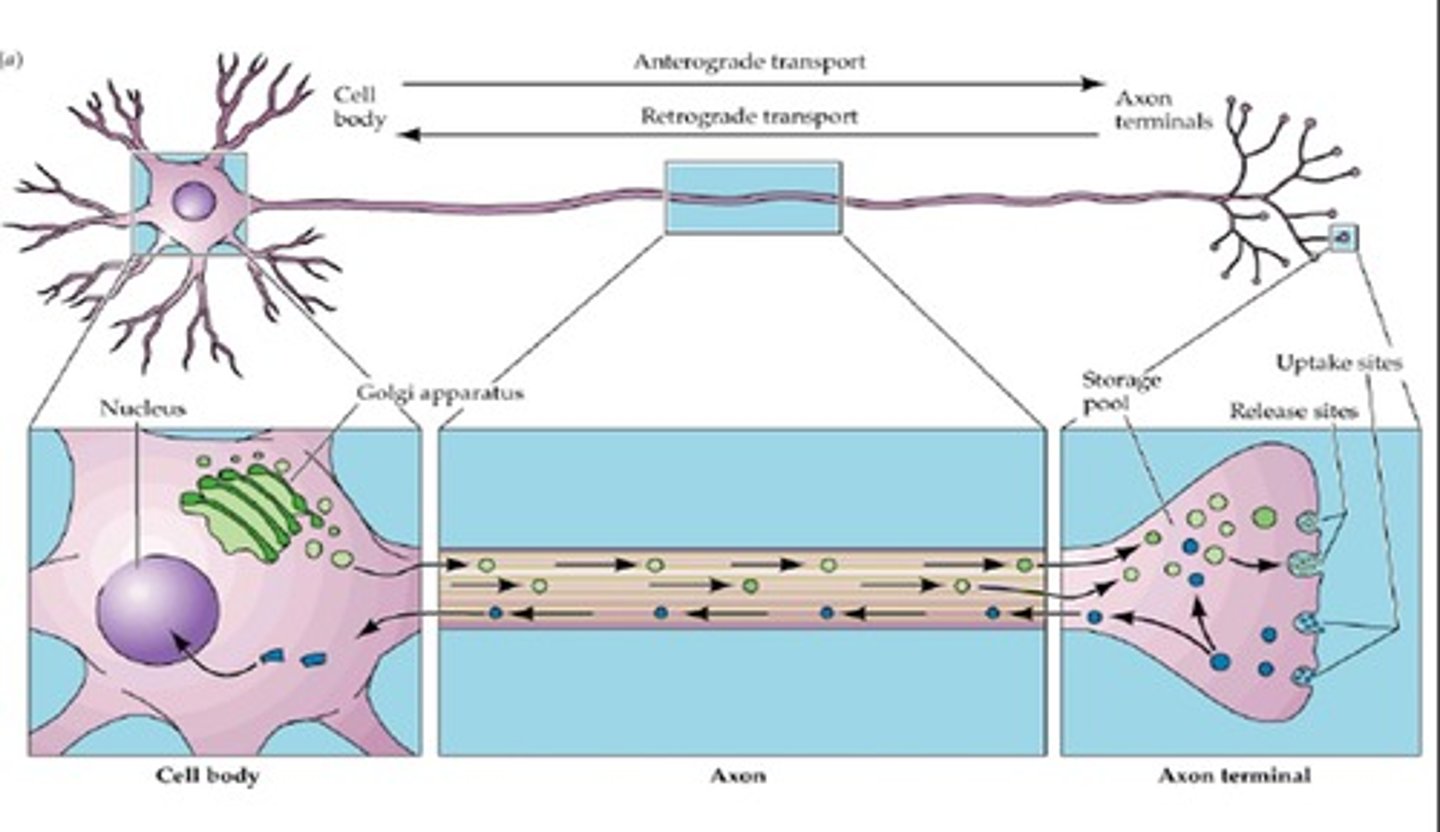
Name and briefly describe the different classes of neurons based on structure.
Multipolar Neuron
Bipolar Neuron
Unipolar Neuron
Anaxoninc Neuron
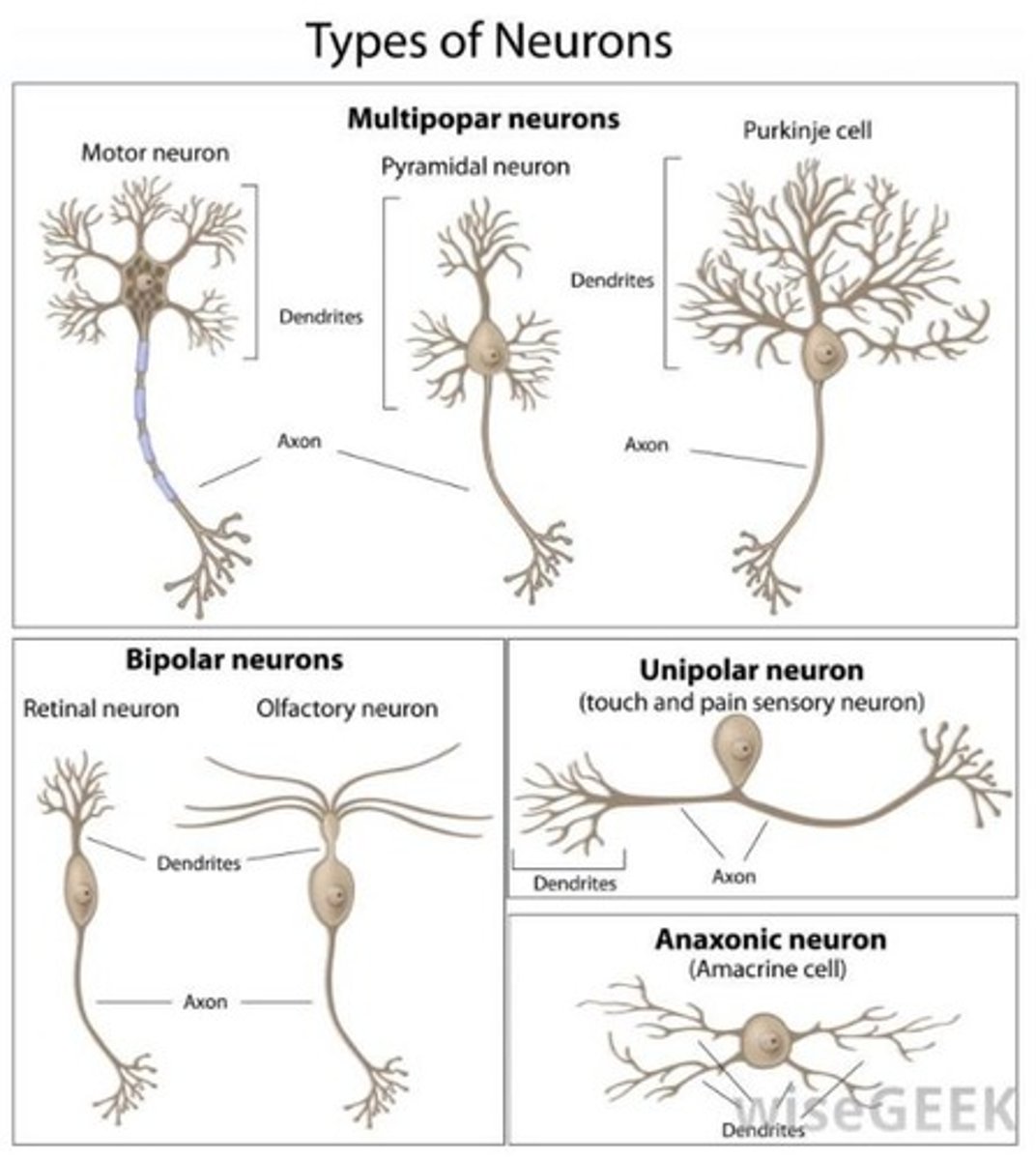
Multipolar Neuron
(All Motor Neurons, Most Interneurons) multiple processes extend directly from the cell body; typically many dendrites and one axon; most common type of neuron.
Bipolar Neuron
(Some Special Sense Neurons - i.e. Retina of Eye, Olfactory Epithelium in Nose) two processes extend directly from the cell body; one dendrite and one axon; relatively limited in where they are located
Unipolar Neuron
(Most Sensory Neurons) single short process extends directly from the cell and looks like a T as a result of the fusion of two processes into one long axon
Anaxoninc Neuron
(Interneurons) processes are only dendrites; no axon present
List and briefly describe the three functional classes of neurons.
Sensory Nerves
Motor Nerves
Interneurons
Sensory Nerves
(afferent neurons) contain only neurons that relay information toward the CNS. Activated when the senses receive stimuli from the environment.
Motor Nerves
(efferent neurons) – contain neurons that relay information away from the CNS. Transmit impulses from the brain and spinal cord to the muscle glands, and organs in the body
Interneurons
(association neurons) - provide interconnections between neurons in the CNS transmits impulses between sensory and motor neurons
Describe the functions of astrocytes (include where they are located).
Astrocyte - largest and most abundant glial cell of the central nervous system
The cell processes have contact with both capillaries and neurons, most abundant glial cells in the central nervous system and constitute over 90% of the nervous tissue in some areas of the brain.
Functions
Nurture, protect, support, and guide neurons
Help form the blood-brain barrier (within the brain
Regulate interstitial fluid composition (within the brain)
Form structural support (within the cytoskeleton)
Assist neuronal development (within the fetal brain)
Alter synaptic activity (within neurons)
Occupy the space of dying neurons (in place of neurons)
Describe the role of oligodendrocytes. Include the terms myelin and nodes of Ranvier in your description.
Oligodendrocytes - category of large glial cells in the CNS that wrap around and insulate axons.
Role - to insulate axons in the CNS by forming a myelin sheath through the process of myelination. Nodes of Ranvier are the spaces in-between the myelin sheaths that are exposed and not insulated.
What is the difference between white and gray matter?
White Matter - brain or spinal cord tissue that derives its color from myelin in myelinated axons
Gray Matter - brain or spinal cord tissue composed of neuron cell bodies, dendrites, and unmyelinated axons.
In your own words, summarize the three concepts that are important in establishing a transmembrane potential.
Concentration: intracellular fluid contains more K+ ions than Na+ ions and the extracellular fluid contains more Na+ ions than K+ ions.
Permeability: cells have selective permeability and control movement across the membrane
Charge: passive and active mechanisms make it so that there is not an equal distribution of charge across the membrane
Explain how chemical and electrical forces act across the cell membrane.
When a neurotransmitter is released from the presynaptic neuron binds with a specific type of channel, chemical or electrical, it triggers it to open and temporarily allows the passage of a small amount of specific type of ion across the plasma membrane.
Chemical Forces - molecules move from an area of high concentration to low concentration down a chemical gradient
Electrical Forces - molecules that have a charge and move across a membrane due to membrane potential
What two ions have the greatest effect on a cell's resting potential? Why?
K+ and Na+
Their concentrations within and outside of the cell create a negative resting potential.
The interior of the cell is negative because of the ability for K+ to diffuse out of cell rather than for Na+ to diffuse into the cell.
What is the purpose of the sodium-potassium pump? What would happen if it stopped working?
Maintains the concentration gradients of Na+ and K+, stabilizing the resting membrane potential.
If the sodium-potassium pump stopped working the electrochemical gradient would find equilibrium stopping the generation of action potentials and the cell would stop doing work.
What are the different types of ion channels found in the cell membrane?
Chemically Gated - closed but temporarily open in response to binding of a neurotransmitter
Voltage Gated - closed but temporarily open in response to changes in electrical charge (potential) across the plasma membrane
Leak Channel - always open, passive, allowing continuous diffusion of a specific type of ion from a region of high concentration to a region of low concentration
Define graded potential
small deflection in the resting membrane potential in excitable cells due to the movement of small amounts of ions across the plasma membrane; may result in either a depolarization or hyperpolarization.
Define depolarization
change in membrane potential or voltage to a more positive value
Define repolarization
change in membrane potential from a depolarized value back to the resting value
Define hyperpolarization
change in the membrane potential to a value more negative than the resting potential
What are the steps involved in the generation of an action potential?
Graded depolarization brings an area of excitable membrane to threshold
Voltage-sensitive Na+ channel activation occurs
Na+ ions cross the cell membrane and further depolarization of the membrane
Voltage-sensitive K+ channels open and K+ moves out across the cell membrane, initiating repolarization of the membrane potential
Temporary hyperpolarization of membrane potential occurs
Gates of the voltage-sensitive Na+ channels reset
Voltage-sensitive K+ channels close and repolarization of the membrane potential occurs
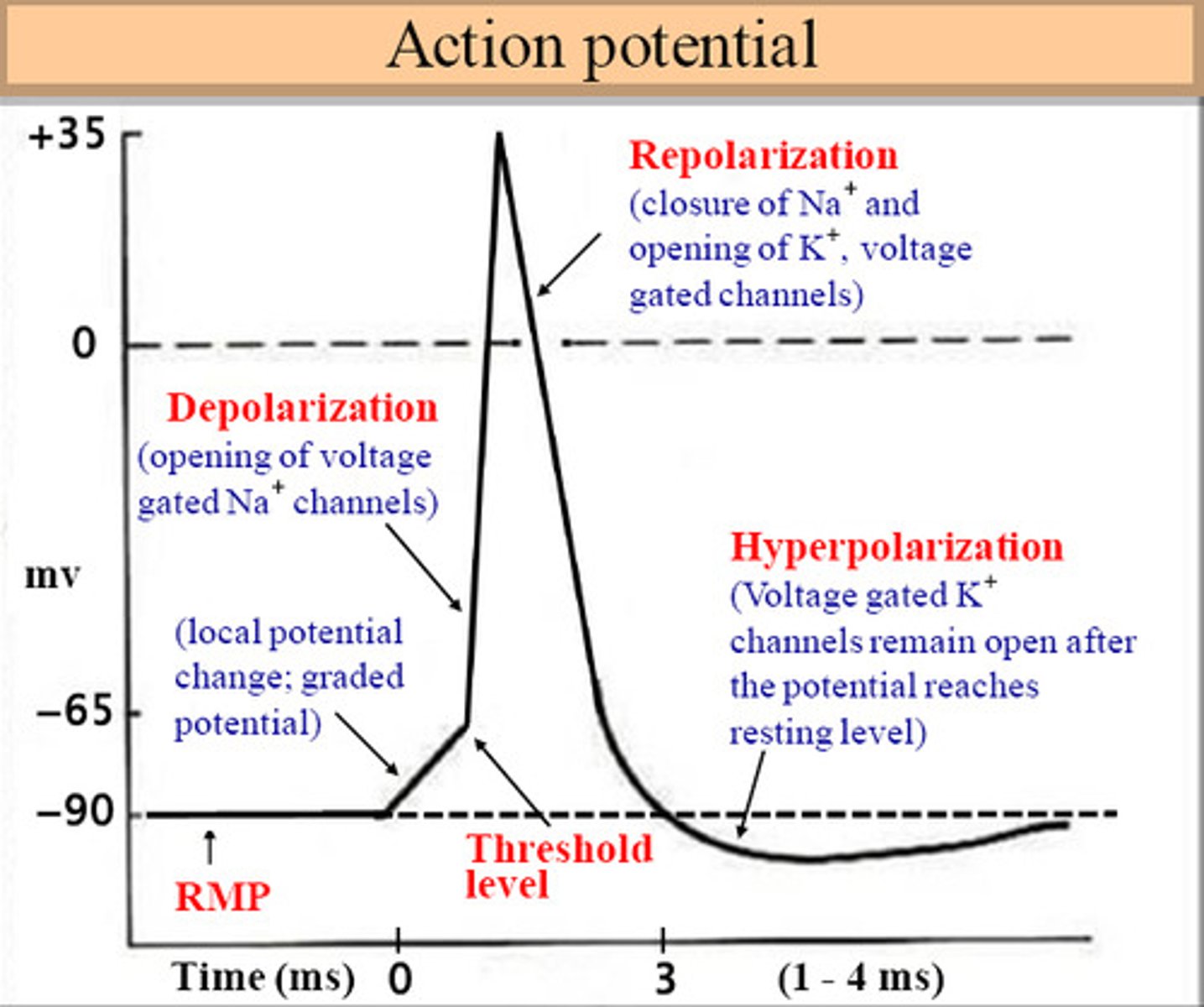
What is saltatory propagation?
Impulse conduction in myelinated nerves occurring by means of 'electrical current leaps from node to node'. (of Ranvier) in one direction toward the synapse.
Propagation of action potentials along myelinated axons from one node of Ranvier to the next node, increasing the conduction of velocity of action potentials.
What's the relationship between axon diameter and propagation speed?
The axon diameter affects how quickly action potential propagates. The larger the axon diameter the quicker the propagation of speed.
What are the 3 types of axons, based on their diameter?
Type A Fibers
Type B Fibers
Type C Fibers
Type A Fibers of Axons
the largest, myelinated axons with potentials of up to 120 m/s
Type B Fibers of Axons
smaller myelinated axons with potentials of up to 18 m/s
Type C Fibers of Axons
unmyelinated, smallest axons with less than 1 m/s
What happens when constant pressure is applied to a nerve?
When constant pressure is applied to a nerve it disrupts the nerve's function. This is what a 'pinched nerve' refers to and it may cause pain, tingling, numbness, or weakness.
The disease rabies is caused by a virus that attacks the central nervous system. The virus is normally introduced by an animal bite that breaks the surface of the skin. Since the virus is not motile, how does it get to the central nervous system?
Bite penetrates muscle, virus infects nerve cells entering a neuron at the synaptic knob, attaches to a cell body by fast axonal transport and travels from the PNS along afferent nerves via retrograde axoplasmic flow to CNS.
What are the major classes of biogenic neurotransmitters?
Catecholamines (Dopamine, Norepinephrine, Epinephrine)
Indolamines (Histamine, Serotonin)
Actions of Norepinephrine
Vasopressor: direct stimulation of alpha-adrenergic receptors, constricting both capacitance and resistance blood
vessels. This result in increased total peripheral vascular resistance, increased systolic and diastolic blood pressure,
and decreased blood flow to vital organs, skin, skeletal muscle and renal blood flow.
Produces a positive inotropic response of the heart (beta1 receptors).
Neurotransmitter of peripheral autonomic nervous system (sympathetic division) and various regions of the CNS
Amphetamines increase release; cocaine decreases removal from synaptic cleft; ecstasy increases release
Actions of Dopamine
Produces inhibitory activity in the brain; important roles in cognition, motivation, behavior, mood
Decreased levels in Parkinson disease
Amphetamines increase release; cocaine decreases removal from synaptic cleft; ecstasy increases release
Actions of Serotonin
Mood
stabilizer, Vasodilate, and Increase Vascular Permeability; Role in Peristalsis and Nausea
Various functions in the brain related to sleep, appetite, cognition, and mood.
Fluoxetine (Prozac) decreases reuptake; ecstasy increases the release; LSD binds to most serotonin receptors
Actions of GABA
Gamma-Aminobutyric Acid
Modified amino acid that is synthesized from glutamate; primary inhibitory neurotransmitter in the brain; influences muscle tone
Alcohol, diazepam (Valium), and barbiturates increase inhibitory effects of GABA
Actions of Endocannabinoids
Most prevalent receptors in the brain.
Lipid-derived messengers sometimes referred to as the brain's marijuana. These messengers control the release of neurotransmitters, usually by inhibiting them, and can affect the immune system and other cellular parameters.
Endocannabinoids also play an important role in the control of behaviors.
Actions of Nitic Oxide
Involved in learning and memory; relaxation of muscle in the digestive tract; relaxation of smooth muscle in blood vessels
What is the action of monoamine oxidase (MAO)
Enzyme present at neural endings. Breaks down catecholamines (norepinephrine and dopamine)
What is the clinical significance of MAO inhibitors?
Prevents the inactivation of biogenic amines by irreversibly inhibiting the enzyme MOA, causing an increase in the number of neurotransmitters available in the synapse
What are EPSP's and IPSP's?
Action potentials involve communication through neurons via axons. Some neurons do not have axons and can only communicate with local neurons via graded potential, which are membrane potentials that vary in intensity (don't follow all or none law). These create EPSPs or IPSPs. EPSPs and IPSPs decide whether or not the postsynaptic cell will fire an action potential
EPSPs
Excitatory Postsynaptic Potential
Neurotransmitter released from presynaptic neurons crosses the synaptic cleft and initiates a graded potential in the postsynaptic neuron (which is a local electrical change from the resting membrane potential). Binding of a neurotransmitter may result in the inside of the neuron becoming less negative. This change in the membrane potential is called an excitatory post synaptic potential (EPSP)
IPSPs
Inhibitory Postsynaptic Potential - Postsynaptic potentials that result in the neuron becoming more negative
Takes neuron away from threshold
Inhibitory post synaptic potentials; post synaptic hyper-polarizations because they decrease the likelihood that the neuron will fire
What is summation
The process of adding up postsynaptic potentials and responding to their net effect.
Accumulation of stimuli occurring in neurons or muscle cells. Summing of all individual changes in a neuron's membrane potential.
Spatial Summation
Multiple presynaptic neurons release neurotransmitters at various locations onto the receptive segment, thus generating EPSPs, IPSPs, or both in the postsynaptic neuron.
Temporal Summation
Single presynaptic neuron repeatedly releases neurotransmitter to produce either multiple EPSPs or IPSPs in the postsynaptic neuron at the same location within a very short period.
Tetrodotoxin is a toxin that blocks the voltage gated sodium channels. What effect would this have on the function of neurons?
Action potential could not be initiated (because Na+ crossing cell membrane is necessary for depolarization to occur, which is step one of an action potential), so neurons would cease to function.
Many medications introduced into the bloodstream cannot directly affect the neurons of the CNS- why?
The CNS is enveloped in an endothelium that is made up of capillaries that form the blood-brain barrier. Astrocytes are neuroglial cells that participate in maintaining the blood-brain barrier by covering the outer surfaces of the CNS capillary endothelial cells
Blood-Brain Barrier
Blood vessels (capillaries) that selectively let certain substances enter the brain tissue and keep other substances out